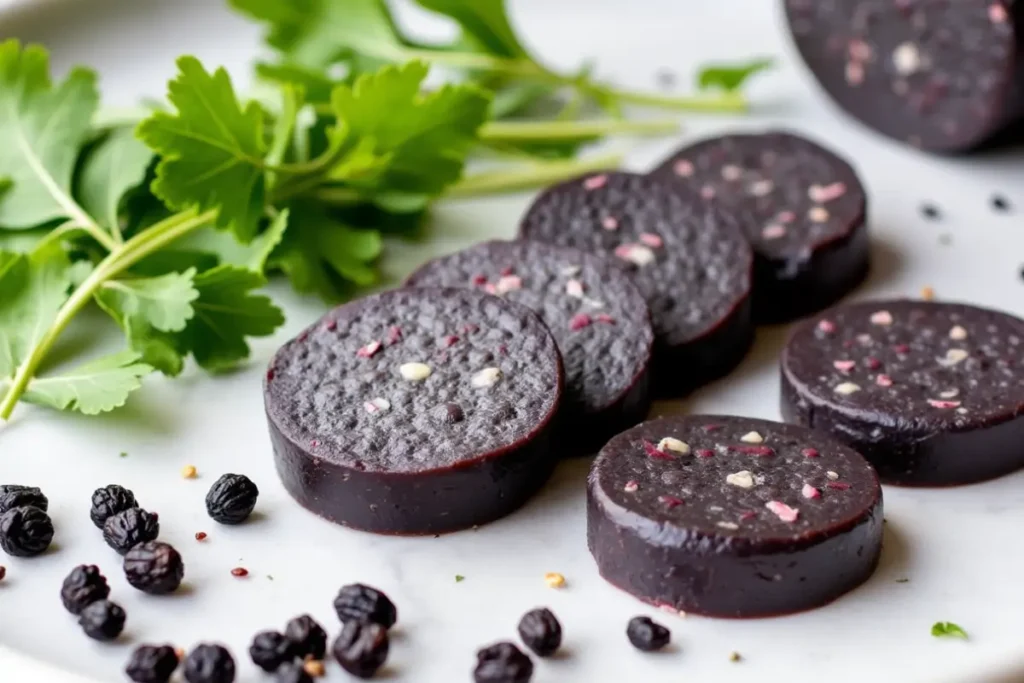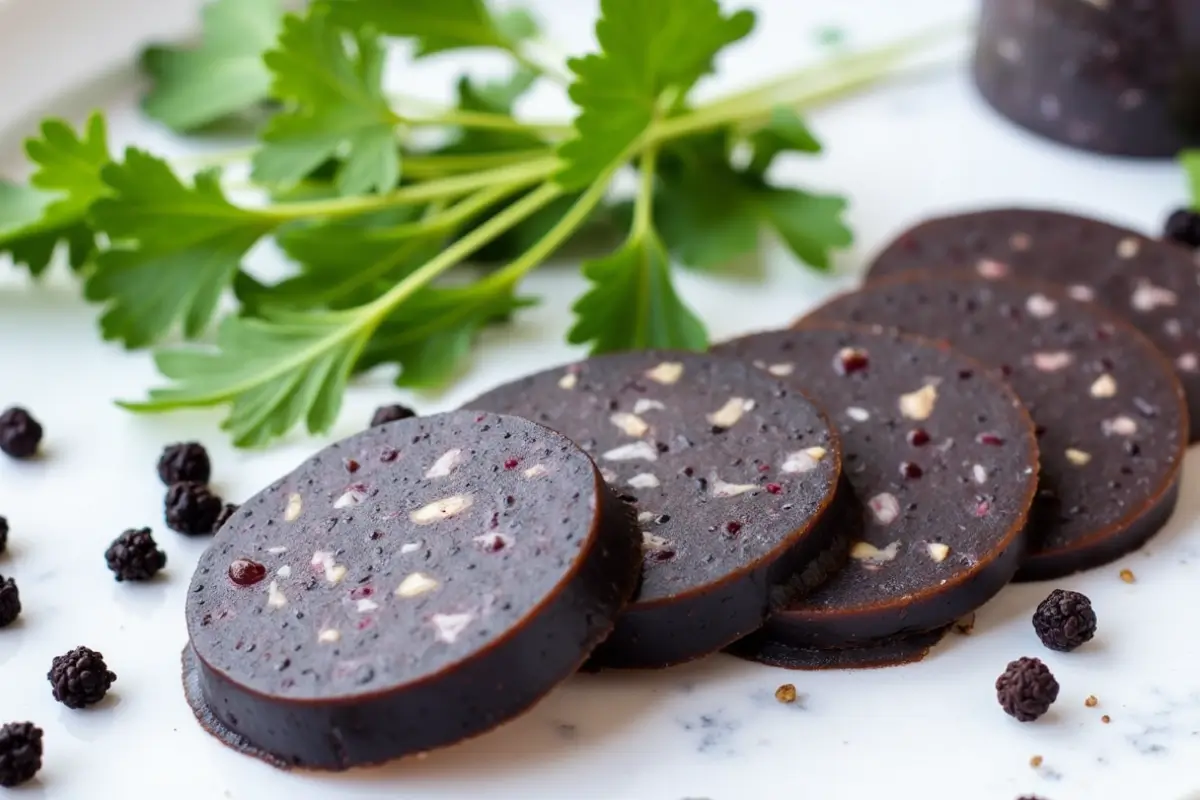Table of Contents
What is Black Pudding?
Black pudding, also known as blood sausage, is a type of sausage made using blood, fat, and grains. Despite its name, it’s not a pudding in the sweet, dessert sense but rather a savory dish enjoyed in breakfasts and gourmet meals alike.
Why is Black Pudding So Popular?
From the UK and Ireland to Spain and France, black pudding has cemented itself as a beloved culinary tradition. Some enjoy it for its deep, earthy flavors, while others value its nutritional benefits, particularly its high iron content.
The Role of Black Pudding in Culinary History
Throughout history, people have found creative ways to utilize every part of an animal, and black pudding is one of the oldest examples of nose-to-tail cooking. It has been around for centuries, appearing in early cookbooks and folk traditions.
Origins and History
Ancient Beginnings: The Birth of Blood Sausage
The concept of using blood in cooking is as old as civilization itself. In fact, the earliest recorded mentions of blood sausage date back to ancient Greece. Even the famous Greek poet Homer referenced a dish resembling black pudding in The Odyssey!
Historians believe that blood sausage was a practical way to use every part of the animal, especially in times when food preservation was challenging. Since fresh blood spoils quickly, early butchers and farmers combined it with grains and fat, then encased it to extend its shelf life.
Medieval Europe: Black Pudding Gains Popularity
During the Middle Ages, black pudding became a staple across Europe. In England, it was a common food among peasants and noblemen alike. It was easy to prepare, rich in nutrients, and provided a hearty meal in harsh winters.
Meanwhile, in France, Spain, and Germany, similar versions of black pudding—like boudin noir and morcilla—became culinary staples. Each region developed its own twist, using local spices, grains, and preparation techniques.
Traditional British and Irish Roots
In the UK and Ireland, black pudding evolved into a signature dish. By the 18th and 19th centuries, it was a must-have in working-class breakfasts. Towns like Bury in England and Stornoway in Scotland became renowned for their unique versions, with some gaining protected status due to their historical significance.
Modern-Day Evolution of Black Pudding
Though deeply rooted in tradition, black pudding has evolved into a gourmet ingredient. Today, top chefs incorporate it into fine dining, pairing it with unexpected flavors and modern presentations. It remains a crucial element in a full English or Irish breakfast, but it’s also appearing in high-end restaurants, adding depth to various dishes.
Traditional Ingredients and Preparation of Black Pudding
What Goes into Black Pudding?
At its core, black pudding is a simple yet flavorful combination of a few key ingredients. While variations exist, the traditional recipe typically includes:
- Animal Blood – The defining ingredient, usually from cows or sheep, giving black pudding its dark color and rich, iron-packed flavor.
- Fat or Suet – Adds a creamy texture and enhances the depth of flavor.
- Grains (Oatmeal or Barley) – Helps absorb the blood and gives the pudding its firm consistency.
- Seasonings & Spices – Depending on the region, common additions include salt, pepper, nutmeg, cloves, and allspice.
Step-by-Step: How Black Pudding is Made
- Mixing the Ingredients – Fresh blood is combined with suet or fat, grains, and seasonings to create a thick, well-seasoned mixture.
- Stuffing the Casings – The mixture is carefully poured into natural casings (traditionally made from cleaned animal intestines).
- Cooking the Sausages – The filled casings are gently simmered in water to firm up the texture and lock in the flavors.
- Cooling and Curing – Once cooked, the black pudding is allowed to cool and cure, intensifying its flavor.
Traditional vs. Modern Preparation Methods
While the traditional method remains popular, modern production has introduced slight variations. Some recipes swap animal blood for plant-based alternatives, making it possible to create vegetarian black pudding using beets, mushrooms, and spices to mimic the original flavor.
Regional Variations of Black Pudding
How Different Countries Interpret Black Pudding
Though black pudding is deeply associated with the UK and Ireland, it’s far from being just a British specialty. Many cultures worldwide have developed their own versions, each with unique flavors, textures, and ingredients.

The UK and Ireland: Home of the Classic Black Pudding
In the British Isles, black pudding has been a staple for centuries, with distinct regional varieties:
- Bury Black Pudding (England): Originating from the market town of Bury, this variety is famous for its deep, rich flavor and smooth texture. Traditionally sold unsliced, it’s often steamed or grilled.
- Stornoway Black Pudding (Scotland): One of the most famous versions, this Scottish delicacy is known for its high-quality ingredients and balanced seasoning. It even has Protected Geographical Indication (PGI) status, meaning only those made in Stornoway can use the name.
- Irish Black Pudding: A key component of a full Irish breakfast, this variety often contains a coarser texture due to a higher ratio of oatmeal. It’s commonly paired with white pudding, which omits blood but retains the grains and fat.
European Takes on Blood Sausage
Many European countries have their own take on black pudding, often with interesting ingredient swaps:
- France – Boudin Noir: A smooth, delicately spiced blood sausage with onions, apples, and sometimes a splash of wine.
- Spain – Morcilla: A deeply flavored blood sausage that varies by region, with rice, onions, or even sweet spices like cinnamon.
- Germany – Blutwurst: A hearty sausage often mixed with pork or beef, featuring a firmer texture and a smoky aroma.
Beyond Europe: Black Pudding Across the World
While black pudding is most commonly associated with Europe, versions of blood sausage exist worldwide:
- Asia – Korea’s Sundae is a steamed blood sausage mixed with noodles and barley.
- Latin America – Argentina’s Morcilla is often enjoyed at barbecues, seasoned with paprika and garlic.
- Africa – Some regions incorporate blood sausages into spicy, stew-like dishes.
Culinary Uses and Pairings of Black Pudding
Full English & Irish Breakfasts – A traditional breakfast wouldn’t be complete without slices of crispy black pudding alongside eggs, sausages, and tomatoes.
- Scottish Breakfast with Stornoway Black Pudding – In Scotland, high-quality Stornoway black pudding is often pan-fried and served with tattie scones.
- Lancashire Hotpot – In Northern England, black pudding is sometimes added to this slow-cooked meat and vegetable dish for extra depth.
- Spanish Morcilla Stews – In Spain, morcilla (a variation of black pudding) is a crucial ingredient in traditional stews like Fabada Asturiana.
Modern Culinary Innovations with Black Pudding
While it remains a staple in classic dishes, black pudding has found its way into gourmet and fusion cuisine. Chefs experiment with it in creative ways, proving that this traditional ingredient is more versatile than many people realize.
- Black Pudding Croquettes – Crispy on the outside, soft and flavorful on the inside, these bite-sized delights are a hit in high-end restaurants.
- Black Pudding Scotch Eggs – A twist on the traditional Scotch egg, replacing the sausage meat with black pudding for an even richer taste.
- Black Pudding and Apple Tart – The sweetness of apples balances the savory, iron-rich flavors of black pudding, making for a unique and delicious appetizer.
- Salads with Black Pudding Crumbles – Lightly crisped black pudding crumbles add a meaty umami punch to fresh greens and tangy dressings.
Best Foods to Pair with Black Pudding
Pairing black pudding with the right foods enhances its flavor and creates a balanced meal. Here are some of the best combinations:
- Apples & Pears – Their natural sweetness contrasts beautifully with the bold, savory notes of black pudding.
- Potatoes – Mashed, roasted, or fried, potatoes provide the perfect creamy or crispy base.
- Eggs – The richness of runny yolks pairs exceptionally well with crispy black pudding.
- Leafy Greens – Ingredients like spinach or kale offer freshness that cuts through the density of black pudding.
Health Benefits and Nutritional Value of Black Pudding
Is Black Pudding Healthy? Understanding Its Nutritional Profile
Many people wonder whether black pudding is a nutritious addition to their diet. Surprisingly, this traditional dish is packed with essential nutrients that can benefit your overall health when consumed in moderation. It’s a rich source of protein, iron, and important vitamins that support energy levels, muscle function, and overall well-being.
High in Protein: A Muscle-Building Powerhouse
One of the standout nutritional benefits of black pudding is its high protein content. Since protein is vital for muscle repair, immune function, and overall cellular health, adding black pudding to your meals can be an easy way to meet your daily protein needs.
Iron-Rich Food: Combatting Fatigue and Anemia
Iron deficiency is a common issue, especially among women and those with restrictive diets. Black pudding provides a significant amount of heme iron, the most absorbable form of iron, which helps combat anemia and fatigue. If you struggle with low energy, incorporating iron-rich foods like black pudding into your diet may help boost your vitality.
Essential Vitamins and Minerals in Black Pudding
This nutrient-dense food isn’t just about protein and iron. It also contains:
- Zinc – Supports immune function and wound healing.
- Magnesium – Aids muscle function and nervous system health.
- B Vitamins – Help convert food into energy and support brain function.
Low-Carb and Keto-Friendly
If you follow a low-carb or keto diet, black pudding can be a great addition to your meal plan. Unlike many processed foods, traditional black pudding contains minimal carbohydrates, making it a perfect fit for those reducing their carb intake.
Potential Health Concerns: Moderation is Key
While black pudding offers numerous health benefits, it’s also high in saturated fat and sodium. Excessive consumption of processed meats may contribute to heart-related issues, so it’s best enjoyed in moderation alongside a balanced diet.
How to Include Black Pudding in a Healthy Diet
To maximize the benefits of black pudding while maintaining a healthy lifestyle, consider these tips:
- Pair it with fiber-rich foods like vegetables to aid digestion.
- Opt for homemade or high-quality versions to avoid excessive additives.
- Enjoy it as part of a well-balanced meal rather than as a frequent indulgence.
Final Thoughts
When eaten responsibly, black pudding can be a nutritious and delicious food choice. Packed with protein, iron, and essential vitamins, it can contribute to a healthy diet while providing a burst of rich flavor.
How to Cook and Enjoy Black Pudding
1. Pan-Frying: The Classic and Crispiest Method
Pan-frying is the most popular way to prepare black pudding, giving it a crispy outer layer while keeping the inside soft.
How to pan-fry black pudding:
- Slice the pudding into ½-inch thick rounds.
- Heat a non-stick pan or cast-iron skillet over medium heat.
- Add a small amount of oil or butter.
- Cook for 2-3 minutes per side until crisp and golden brown.
2. Grilling: A Healthier Alternative
Steps to grill black pudding:
- Preheat the grill to medium heat.
- Place slices on the grill rack.
- Cook for 3-4 minutes on each side, turning once.
3. Baking: A Simple and Mess-Free Option
Baking is great for cooking larger batches without the mess of frying.
How to bake black pudding:
- Preheat oven to 375°F (190°C).
- Place slices on a baking sheet lined with parchment paper.
- Bake for 15-20 minutes, flipping halfway through.
4. Boiling: For Soft and Juicy Black Pudding
Some prefer black pudding soft rather than crispy, and boiling preserves its moisture.
Steps to boil black pudding:
- Bring a pot of water to a gentle simmer (not boiling).
- Place the whole sausage (uncut) in the water.
- Simmer for 10-15 minutes, then remove and let it rest before slicing.
Delicious Ways to Enjoy Black Pudding
Black pudding isn’t just for breakfast! It pairs well with a variety of dishes and flavors.
1. Traditional Breakfast Plate
A classic British or Irish breakfast often includes black pudding alongside:
- Fried eggs
- Grilled tomatoes
- Mushrooms
- Toast
2. Black Pudding and Potato Hash
Dice black pudding and sauté it with potatoes, onions, and peppers for a hearty meal.
3. In a Salad
Crumble black pudding over a fresh salad with arugula, walnuts, and a balsamic dressing for a rich, earthy flavor.
4. In Stews and Casseroles
Black pudding adds depth to stews, soups, and slow-cooked casseroles. Try adding it to a lentil stew for extra protein and flavor.
Tips for Choosing the Best Black Pudding
- Look for artisanal or high-quality brands with minimal additives.
- Choose fresh over processed varieties for better flavor and texture.
- Check ingredient lists for traditional recipes with natural ingredients.
How to Store Black Pudding
Proper storage is key to maintaining the freshness and flavor of black pudding.
1. Storing Fresh Black Pudding
- Keep it refrigerated at or below 40°F (4°C).
- Use within 5-7 days if unopened.
- Once opened, consume within 2-3 days.
2. Freezing for Long-Term Storage
- Wrap slices individually in plastic wrap or foil.
- Place in a sealed freezer bag to prevent freezer burn.
- Store for up to 3 months for best quality.
3. Defrosting and Reheating
- Thaw in the refrigerator overnight for best results.
- Reheat using a pan-fry, grill, or oven method for optimal taste and texture.
Signs That Black Pudding Has Gone Bad
To ensure food safety, always check for:
- Unpleasant sour or rancid odor
- Slimy or sticky texture
- Visible mold or discoloration

